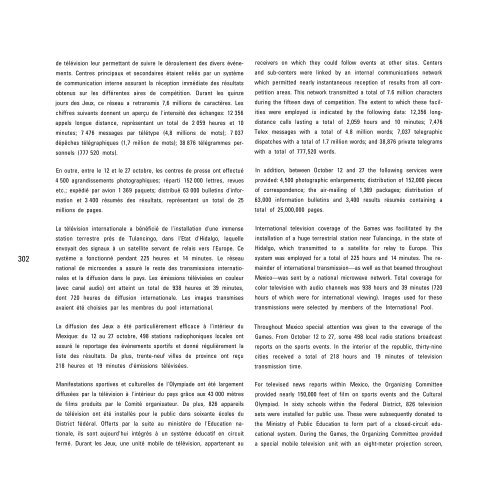Mexico City Olympic Games Official Report ... - LA84 Foundation
Mexico City Olympic Games Official Report ... - LA84 Foundation
Mexico City Olympic Games Official Report ... - LA84 Foundation
Create successful ePaper yourself
Turn your PDF publications into a flip-book with our unique Google optimized e-Paper software.
302<br />
de télévision leur permettant de suivre le déroulement des divers événe-<br />
ments. Centres principaux et secondaires étaient reliés par un système<br />
de communication interne assurant la réception immédiate des résultats<br />
obtenus sur les différentes aires de compétition. Durant les quinze<br />
jours des Jeux, ce réseau a retransmis 7,6 millions de caractères. Les<br />
chiffres suivants donnent un aperçu de l'intensité des échanges: 12 356<br />
appels longue distance, représentant un total de 2 059 heures et 10<br />
minutes; 7 476 messages par télétype (4,8 millions de mots); 7 037<br />
dépêches télégraphiques (1,7 million de mots); 38 876 télégrammes per-<br />
sonnels (777 520 mots).<br />
En outre, entre le 12 et le 27 octobre, les centres de presse ont effectué<br />
4 500 agrandissements photographiques; réparti 152 000 lettres, revues<br />
etc.; expédié par avion 1 369 paquets; distribué 63 000 bulletins d'infor-<br />
mation et 3 400 résumés des résultats, représentant un total de 25<br />
millions de pages.<br />
Le télévision internationale a bénéficié de l'installation d'une immense<br />
station terrestre près de Tulancingo, dans l'Etat d'Hidalgo, laquelle<br />
envoyait des signaux à un satellite servant de relais vers l'Europe. Ce<br />
système a fonctionné pendant 225 heures et 14 minutes. Le réseau<br />
national de microondes a assuré le reste des transmissions internatio-<br />
nales et la diffusion dans le pays. Les émissions télévisées en couleur<br />
(avec canal audio) ont atteint un total de 938 heures et 39 minutes,<br />
dont 720 heures de diffusion internationale. Les images transmises<br />
avaient été choisies par les membres du pool international.<br />
La diffusion des Jeux a été particulièrement efficace à l'intérieur du<br />
Mexique: du 12 au 27 octobre, 498 stations radiophoniques locales ont<br />
assuré le reportage des événements sportifs et donné régulièrement la<br />
liste des résultats. De plus, trente-neuf villes de province ont reçu<br />
218 heures et 19 minutes d'émissions télévisées.<br />
Manifestations sportives et culturelles de l'Olympiade ont été largement<br />
diffusées par la télévision à l'intérieur du pays grâce aux 43 000 mètres<br />
de films produits par le Comité organisateur. De plus, 826 appareils<br />
de télévision ont été installés pour le public dans soixante écoles du<br />
District fédéral. Offerts par la suite au ministère de l'Education na-<br />
tionale, ils sont aujourd'hui intégrés à un système éducatif en circuit<br />
fermé. Durant les Jeux, une unité mobile de télévision, appartenant au<br />
receivers on which they could follow events at other sites. Centers<br />
and sub-centers were linked by an internal communications network<br />
which permitted nearly instantaneous reception of results from all com-<br />
petition areas. This network transmitted a total of 7.6 million characters<br />
during the fifteen days of competition. The extent to which these facil-<br />
ities were employed is indicated by the following data: 12,356 long-<br />
distance calls lasting a total of 2,059 hours and 10 minutes; 7,476<br />
Telex messages with a total of 4.8 million words; 7,037 telegraphic<br />
dispatches with a total of 1.7 million words; and 38,876 private telegrams<br />
with a total of 777,520 words.<br />
In addition, between October 12 and 27 the following services were<br />
provided: 4,500 photographic enlargements; distribution of 152,000 pieces<br />
of correspondence; the air-mailing of 1,369 packages; distribution of<br />
63,000 information bulletins and 3,400 results résumés containing a<br />
total of 25,000,000 pages.<br />
International television coverage of the <strong>Games</strong> was facilitated by the<br />
installation of a huge terrestrial station near Tulancingo, in the state of<br />
Hidalgo, which transmitted to a satellite for relay to Europe. This<br />
system was employed for a total of 225 hours and 14 minutes. The re-<br />
mainder of international transmission—as well as that beamed throughout<br />
<strong>Mexico</strong>—was sent by a national microwave network. Total coverage for<br />
color television with audio channels was 938 hours and 39 minutes (720<br />
hours of which were for international viewing). Images used for these<br />
transmissions were selected by members of the International Pool.<br />
Throughout <strong>Mexico</strong> special attention was given to the coverage of the<br />
<strong>Games</strong>. From October 12 to 27, some 498 local radio stations broadcast<br />
reports on the sports events. In the interior of the republic, thirty-nine<br />
cities received a total of 218 hours and 19 minutes of television<br />
transmission time.<br />
For televised news reports within <strong>Mexico</strong>, the Organizing Committee<br />
provided nearly 150,000 feet of film on sports events and the Cultural<br />
Olympiad. In sixty schools within the Federal District, 826 television<br />
sets were installed for public use. These were subsequently donated to<br />
the Ministry of Public Education to form part of a closed-circuit edu-<br />
cational system. During the <strong>Games</strong>, the Organizing Committee provided<br />
a special mobile television unit with an eight-meter projection screen,
















